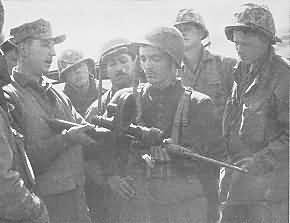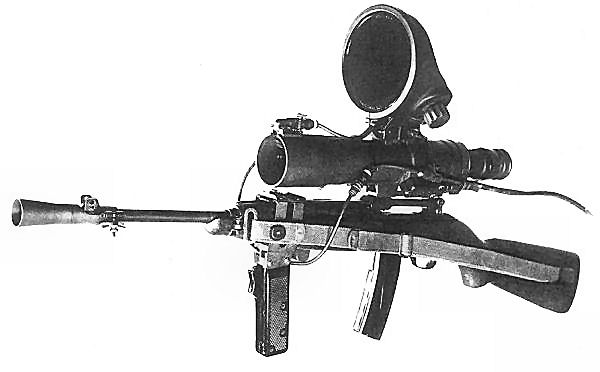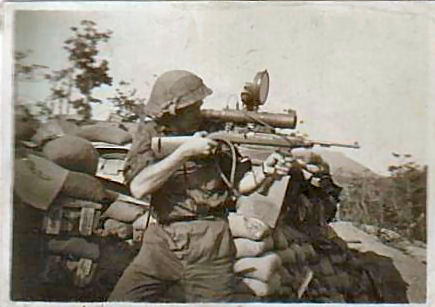The Sniperscope evolved from the M1 of WWII, with an effective range of about 70 yards, to the M2, with a range of about 100 yards. Both of these used vibrator power supplies to convert 6 volt battery levels to 4250 volts for the image-viewing tube. IR rays are focused on the image tubes, causing electrons to be emitted, which are then accelerated and strike a fluorescent screen, converting the sub-visible-light image to the visible light range, showing all objects as various shades of green. Besides enabling detection of enemy movement, and placing full-automatic fire upon them with complete surprise, IR units facilitate night communications between nearby units. Simple, pre-determined coded signals from a flashlight with an infra-red filter could be detected up to 500 yards. The M3, actually available for the Korean War, used 20,000 volts, had an effective range of 125 yards, and could detect ir-flashlight signals up to 1 mile.
The US Carbine, Caliber .30in, M3, or T3, was an M2 carbine with suitable mountings prepared on the receiver to take various models of infra-red night-sighting devices, and an M3 flash hider. No open or conventional sights were provided. The M3 carbine, (its development title was T3), was produced in limited numbers as a semi-prototype. Only about 2100 were manufactured compared to 5,510,000 M1 carbines, 150,000 M1A1 carbines and 570,000 M2 carbines.
| Few combat personnel in the Korean War were aware that the US possessed infrared night-vision capability. Those who did know, didn't welcome them. Objections were mostly focused on their bulk and susceptibility to damage. In late 1952, riflemen from the 5th Marines are weighing the possible usefulness of the M3 Sniperscope. | 
|
In part, the poor reception by combat units of night vision weapons was because the Sniperscope M1 did indeed have significant flaws, as did all the IR series. The telescope can be damaged by direct sunlight or other intense light sources, images are hazed by natural light such as from the moon or stars, and rain or fog greatly reduce range. The M2 flash hider also caused problems. The purpose of a flash hider is not to hide the weapon from the enemy; all rifles are visible to those fired on at night. It is to prevent muzzle blast from degrading the rifleman's night vision. And with IR weapons, to prevent blast and light reflection from confusing the IR detector. Also, should the enemy have IR detection devices, or have captured units of ours, using any IR source simply exposes their position.
However, the vastly improved Sniperscope M3, with almost double the effective range of the M1, with a less vulnerably located IR light source, and with the T23 flash hider was available at about the start of the Korean War, and would have had a deadly effect in the enemy staging phases of most night actions. Supplying only the M3, and in quantity, would have made the value of the weapon much more obvious, particularly if done before we faced the CCF so as to enable proper training.



